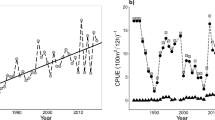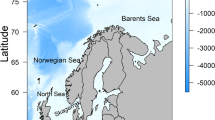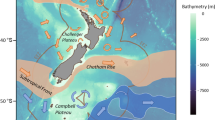Abstract
Life history strategies shape many aspects of species’ ecological importance and population demographics. For ectotherms, life history strategies are highly dependent on temperature, among other environmental conditions. With projected increases in global temperatures, understanding the success of organisms under warmer conditions is critical. Due to the difficulty of establishing long-term heating studies on whole lake systems, there is little empirical evidence addressing the potential changes in life history strategies of fish in situ in response to future climate warming predictions. Here, we study early growth rates, size-at-maturation, maximum adult size, and lifespan of bluegill sunfish in three lakes in Illinois from 2013 to 2017 that experience above-ambient temperatures year-round due to artificial heating by electrical power plant cooling systems and compare these to populations in three nearby ambient lakes. Temperature changes in the heated lakes are within the range of temperature increases predicted by the year 2100. We find evidence that life history strategies and population demographics are substantially affected by warmer environments. Heated populations showed 22% faster first-year growth, 23% shorter lifespans, greater rates of maturation at small body sizes, and over a 4-fold reduction in the relative number of individuals that reach large sizes. Changes in life history strategies, including lifespan and maximum sizes, will be evident across many fish species under warmer conditions in the future and further research should aim to address how these changes will affect trophic interactions.





Similar content being viewed by others
References
Aday DD, Kush CM, Wahl DH, Philipp DP (2002) The influence of stunted body size on the reproductive ecology of bluegill Lepomis macrochirus. Ecol Freshw Fish 11(3):190–195. https://doi.org/10.1034/j.1600-0633.2002.00011.x
Aday DD, Wahl DH, Philipp DP (2003) Assessing population-specific and environmental influences on bluegill life histories: a common garden approach. Ecology 84(12):3370–3375
Aday DD, Philipp DP, Wahl DH (2006) Sex-specific life history patterns in bluegill (Lepomis macrochirus): interacting mechanisms influence individual body size. Oecologia 147(1):31–38. https://doi.org/10.1007/s00442-005-0242-x
Amundsen PA (2016) Contrasting life-history strategies facilitated by cannibalism in a stunted Arctic charr population. Hydrobiologia 783(1):11–19. https://doi.org/10.1007/s10750-015-2600-y
Anderson RO, Gutreuter SJ (1983) Length, weight, and associated structural indices fisheries techniques. American Fisheries Society, Bethesda, Maryland
Annala JH, McKoy JL, Booth JD, Pike RB (1980) Size at the onset of sexual maturity in female Jasus edwardsii (Decapoda, palinuridae) in New Zealand. N Z J Mar Freshw Res 14(3):217–227. https://doi.org/10.1080/00288330.1980.9515864
Arendt JD (2011) Size-fecundity relationships, growth trajectories, and the temperature-size rule for ectotherms. Evolution 65(1):43–51. https://doi.org/10.1111/j.1558-5646.2010.01112.x
Atkinson D (1994) Temperature and organism size – a biological law for ectotherms. Adv Ecol Res 25(25):1–58. https://doi.org/10.1016/s0065-2504(08)60212-3
Atkinson D (1995) Effects of temperature on the size of aquatic ectotherms – exceptions to the general rule. J Therm Biol 20(1–2):61–74. https://doi.org/10.1016/0306-4565(94)00028-h
Atkinson D, Sibly RM (1997) Why are organisms usually bigger in colder environments? Making sense of a life history puzzle. Trends Ecol Evol 12(6):235–239. https://doi.org/10.1016/s0169-5347(97)01058-6
Ballew NG, Mittelbach GG, Scribner KT (2017) Fitness consequences of boldness in juvenile and adult largemouth bass. Am Nat 189(4):396–406. https://doi.org/10.1086/690909
Barr DJ, Levy R, Scheepers C, Tily HJ (2013) Random effects structure for confirmatory hypothesis testing: keep it maximal. J Mem Lang 68(3):255–278. https://doi.org/10.1016/j.jml.2012.11.001
Bassar RD, Marshall MC, López-Sepulcre A, Zandonà E, Auer SK, Travis J, Pringle CM, Flecker AS, Thomas SA, Fraser DF, Reznick DN (2010) Local adaptation in Trinidadian guppies alters ecosystem processes. Proc Natl Acad Sci U S A 107(8):3616–3621. https://doi.org/10.1073/pnas.0908023107
Bates D, Machler M, Bolker BM, Walker SC (2015) Fitting linear mixed-effects models using lme4. J Stat Softw 67(1):1–48
Beard TD Jr, Essington TE (2000) Effects of angling and life history processes on bluegill size structure: insights from an individual-based model. Trans Am Fish Soc 129(2):561–568
Beitinger TL, Magnuson JJ (1979) Growth rates and temperature selection of bluegill, Lepomis macrochirus. Trans Am Fish Soc 108(4):378–382. https://doi.org/10.1577/1548-8659(1979)108<378:gratso>2.0.co;2
Berrigan D, Charnov EL (1994) Reaction norms for age and size at maturity in response to temperature – a puzzle for life historians. Oikos 70(3):474–478. https://doi.org/10.2307/3545787
Biro PA, Stamps JA (2010) Do consistent individual differences in metabolic rate promote consistent individual differences in behavior? Trends Ecol Evol 25(11):653–659. https://doi.org/10.1016/j.tree.2010.08.003
Blazek R, Polacik M, Reichard M (2013) Rapid growth, early maturation and short generation time in African annual fishes. Evodevo 4:7. https://doi.org/10.1186/2041-9139-4-24
Bolker BM, Brooks ME, Clark CJ, Geange SW, Poulsen JR, Stevens MHH, White JSS (2009) Generalized linear mixed models: a practical guide for ecology and evolution. Trends Ecol Evol 24(3):127–135. https://doi.org/10.1016/j.tree.2008.10.008
Bruton MN (1989) The ecological significance of alternative life-history styles. In: Alternative life-history styles of animals. Springer, pp 503–553
Cox SP, Hinch SG (1997) Changes in size at maturity of Fraser River sockeye salmon (Oncorhynchus nerka) (1952-1993) and associations with temperature. Can J Fish Aquat Sci 54(5):1159–1165
Cutts C, Betcalfe N, Caylor A (1998) Aggression and growth depression in juvenile Atlantic salmon: the consequences of individual variation in standard metabolic rate. J Fish Biol 52(5):1026–1037
Daufresne M, Lengfellner K, Sommer U (2009) Global warming benefits the small in aquatic ecosystems. Proc Natl Acad Sci U S A 106(31):12788–12793. https://doi.org/10.1073/pnas.0902080106
Dembski S, Masson G, Monnier D, Wagner P, Phan JC (2006) Consequences of elevated temperatures on life-history traits of an introduced fish, pumpkinseed Lepomis gibbosus. J Fish Biol 69(2):331–346. https://doi.org/10.1111/j.1095-8649.2006.01087.x
Diana JS (1987) Simulation of mechanisms causing stunting in northern pike populations. Trans Am Fish Soc 116(4):612–617
Forsatkar MN, Nematollahi MA, Biro PA, Beckmann C (2016) Individual boldness traits influenced by temperature in male Siamese fighting fish. Physiol Behav 165:267–272. https://doi.org/10.1016/j.physbeh.2016.08.007
Gabelhouse DW Jr (1984) A length‐categorization system to assess fish stocks. N Am J Fish Manag 4(3):273–285
Gardner JL, Peters A, Kearney MR, Joseph L, Heinsohn R (2011) Declining body size: a third universal response to warming? Trends Ecol Evol 26(6):285–291. https://doi.org/10.1016/j.tree.2011.03.005
Garvey JE, Stein RA (1998) Linking bluegill and gizzard shad prey assemblages to growth of age-0 largemouth bass in reservoirs. Trans Am Fish Soc 127(1):70–83. https://doi.org/10.1577/1548-8659(1998)127<0070:lbagsp>2.0.co;2
Gliwicz ZM, Boavida MJ (1996) Clutch size and body size at first reproduction in Daphnia pulicaria at different levels of food and predation. J Plankton Res 18(6):863–880. https://doi.org/10.1093/plankt/18.6.863
Goulet CT, Thompson MB, Michelangeli M, Wong BBM, Chapple DG (2017) Thermal physiology: a new dimension of the pace-of-life syndrome. J Anim Ecol 86(5):1269–1280. https://doi.org/10.1111/1365-2656.12718
Gross MR, Charnov EL (1980) Alternative male life histories in bluegill sunfish. Proc Natl Acad Sci 77(11):6937–6940
Guy CS, Willis DW (1990) Structural relationships of largemouth bass and bluegill populations in South Dakota USA ponds. N Am J Fish Manag 10(3):338–343. https://doi.org/10.1577/1548-8675(1990)010<0338:srolba>2.3.co;2
Hambright KD, Trebatoski RJ, Drenner RW, Kettle D (1986) Experimental study of the impacts of bluegill (Lepomis macrochirus) and largemouth bass (Micropterus salmoides) on pond community structure. Can J Fish Aquat Sci 43(6):1171–1176. https://doi.org/10.1139/f86-146
Hoxmeier RJH, Aday DD, Wahl DH (2009) Examining Interpopulation variation in bluegill growth rates and size structure: effects of harvest, maturation, and environmental variables. Trans Am Fish Soc 138(2):423–432. https://doi.org/10.1577/t08-076.1
Hoyle JA, Keast A (1987) The effect of prey morphology and size on handling time in a piscivore, the largemouth bass (Micropterus salmoides). Canadian Journal of Zoology-Revue Canadienne De Zoologie 65(8):1972–1977. https://doi.org/10.1139/z87-300
Hsu C-Y, Chiu Y-C (2009) Ambient temperature influences aging in an annual fish (Nothobranchius rachovii). Aging Cell 8(6):726–737. https://doi.org/10.1111/j.1474-9726.2009.00525.x
Intergovernmental Panel on Climate Change (2015) Climate change 2014 - impacts, adaptation and vulnerability: Part A: Global and Sectoral Aspects Working Group II Contribution to the IPCC Fifth Assessment Report. Volume 1. Global and Sectoral Aspects, 1140 pp
Irons KS, Sass GG, McClelland MA, Stafford JD (2007) Reduced condition factor of two native fish species coincident with invasion of non-native Asian carps in the Illinois River, USA - is this evidence for competition and reduced fitness? J Fish Biol 71:258–273. https://doi.org/10.1111/j.1095-8649.2007.01670.x
Jeppesen E, Meerhoff M, Holmgren K, González-Bergonzoni I, Teixeira-de Mello F, Declerck SAJ, de Meester L, Søndergaard M, Lauridsen TL, Bjerring R, Conde-Porcuna JM, Mazzeo N, Iglesias C, Reizenstein M, Malmquist HJ, Liu Z, Balayla D, Lazzaro X (2010) Impacts of climate warming on lake fish community structure and potential effects on ecosystem function. Hydrobiologia 646(1):73–90. https://doi.org/10.1007/s10750-010-0171-5
Jonsson N, Jonsson B (2004) Size and age of maturity of Atlantic salmon correlate with the North Atlantic oscillation index (NAOI). J Fish Biol 64(1):241–247. https://doi.org/10.1111/j.1095-8649.2004.00269.x
Kingsolver JG, Huey RB (2008) Size, temperature, and fitness: three rules. Evol Ecol Res 10(2):251–268
Lynch AJ, Myers BJE, Chu C, Eby LA, Falke JA, Kovach RP, Krabbenhoft TJ, Kwak TJ, Lyons J, Paukert CP, Whitney JE (2016) Climate change effects on north American inland fish populations and assemblages. Fisheries 41(7):346–361. https://doi.org/10.1080/03632415.2016.1186016
Martinez E, Porreca AP, Colombo RE, Menze MA (2016) Tradeoffs of warm adaptation in aquatic ectotherms: live fast, die young ? Comparative Biochemistry and Physiology a-Molecular & Integrative Physiology 191:209–215. https://doi.org/10.1016/j.cbpa.2015.07.014
Masclaux H, Bec A, Kainz MJ, Desvilettes C, Jouve L, Bourdier G (2009) Combined effects of food quality and temperature on somatic growth and reproduction of two freshwater cladocerans. Limnol Oceanogr 54(4):1323–1332. https://doi.org/10.4319/lo.2009.54.4.1323
Mulhollem JJ, Colombo RE, Wahl DH (2016) Effects of heated effluent on Midwestern US lakes: implications for future climate change. Aquat Sci 78(4):743–753. https://doi.org/10.1007/s00027-016-0466-3
Neff BD, Fu P, Gross MR (2003) Sperm investment and alternative mating tactics in bluegill sunfish (Lepomis macrochirus). Behav Ecol 14(5):634–641
Neuheimer AB, Gronkjaer P (2012) Climate effects on size-at-age: growth in warming waters compensates for earlier maturity in an exploited marine fish. Glob Chang Biol 18(6):1812–1822. https://doi.org/10.1111/j.1365-2486.2012.02673.x
Oplinger RW, Wahl DH, Nannini MA (2011) Effect of predators on growth and reproductive investment in bluegills: comparison of populations with differing size and age of maturation. Trans Am Fish Soc 140(6):1532–1539
Orcutt JD, Porter KG (1983) Diel vertical migration by zooplankton – constant and fluctuating temperature effects on life-history parameters of Daphnia. Limnol Oceanogr 28(4):720–730. https://doi.org/10.4319/lo.1983.28.4.0720
Otero J, Jensen AJ, L'Abée-Lund JH, Stenseth NC, Storvik GO, Vøllestad LA (2012) Contemporary Ocean warming and freshwater conditions are related to later sea age at maturity in Atlantic salmon spawning in Norwegian rivers. Ecology and Evolution 2(9):2192–2203
Pankhurst NW, Munday PL (2011) Effects of climate change on fish reproduction and early life history stages. Mar Freshw Res 62(9):1015–1026. https://doi.org/10.1071/mf10269
Parmesan C, Yohe G (2003) A globally coherent fingerprint of climate change impacts across natural systems. Nature 421(6918):37–42. https://doi.org/10.1038/nature01286
Partridge L, Harvey PH (1988) The ecological context of life history evolution. Science 241(4872):1449–1455
Pepin P (1991) Effect of temperature and size on development, mortality, and survival rates of the pelagic early LIFE-history stages of marine fish. Can J Fish Aquat Sci 48(3):503–518. https://doi.org/10.1139/f91-065
Pershing AJ, Alexander MA, Hernandez CM, Kerr LA, le Bris A, Mills KE, Nye JA, Record NR, Scannell HA, Scott JD, Sherwood GD, Thomas AC (2015) Slow adaptation in the face of rapid warming leads to collapse of the Gulf of Maine cod fishery. Science 350(6262):809–812. https://doi.org/10.1126/science.aac9819
Pörtner HO, Farrell AP (2008) ECOLOGY physiology and climate change. Science 322(5902):690–692. https://doi.org/10.1126/science.1163156
Pörtner HO, Knust R (2007) Climate change affects marine fishes through the oxygen limitation of thermal tolerance. Science 315(5808):95–97
R Core Team (2018) R: A language and environment for statistical computing. R Foundation for Statistical Computing, Vienna, Austria. https://www.R-project.org/
Rall BC, Vucic-Pestic O, Ehnes RB, Emmerson M, Brose U (2010) Temperature, predator-prey interaction strength and population stability. Glob Chang Biol 16(8):2145–2157. https://doi.org/10.1111/j.1365-2486.2009.02124.x
Sandblom E, Clark TD, Gräns A, Ekström A, Brijs J, Sundström LF, Odelström A, Adill A, Aho T, Jutfelt F (2016) Physiological constraints to climate warming in fish follow principles of plastic floors and concrete ceilings. Nat Commun 7:8. https://doi.org/10.1038/ncomms11447
Sentis A, Hemptinne J-L, Brodeur J (2012) Using functional response modeling to investigate the effect of temperature on predator feeding rate and energetic efficiency. Oecologia 169(4):1117–1125
Somero GN (2010) The physiology of climate change: how potentials for acclimatization and genetic adaptation will determine 'winners' and 'losers'. J Exp Biol 213(6):912–920. https://doi.org/10.1242/jeb.037473
Stenseth NC, Mysterud A (2002) Climate, changing phenology, and other life history and traits: nonlinearity and match-mismatch to the environment. Proc Natl Acad Sci U S A 99(21):13379–13381. https://doi.org/10.1073/pnas.212519399
Stoks R, De Block M, Van de Meutter F, Johansson F (2005) Predation cost of rapid growth: behavioural coupling and physiological decoupling. J Anim Ecol 74(4):708–715. https://doi.org/10.1111/j.1365-2656.2005.00969.x
Tingley RW III, Hansen JF, Isermann DA, Fulton DC, Musch A, Paukert CP (2019) Characterizing angler preferences for largemouth bass, bluegill, and walleye fisheries in Wisconsin. N Am J Fish Manag 39(4):676–692
Walters CJ, Juanes F (1993) Recruitment limitation as a consequence of natural-selection for use of restricted feeding habitats and predation risk-taking by juvenile fishes. Can J Fish Aquat Sci 50(10):2058–2070. https://doi.org/10.1139/f93-229
Walther GR, Post E, Convey P, Menzel A, Parmesan C, Beebee TJC, Fromentin JM, Hoegh-Guldberg O, Bairlein F (2002) Ecological responses to recent climate change. Nature 416(6879):389–395. https://doi.org/10.1038/416389a
Werner EE, Hall DJ (1974) Optimal foraging and size selection of prey by bluegill sunfish (Lepomis macrochirus). Ecology 55:1042–1052
Werner EE, Hall DJ (1988) Ontogenetic habitat shifts in bluegill – The foraging rate predation risk trade-off. Ecology 69:1352–1366
White DP (2019) Effects of environmental warming on lentic freshwater communities and the behavioral and physiological responses by fishes to warming. Dissertation, University of Illinois at Urbana-Champaign
White DP, Wahl DH (2020) Growth and physiological responses in largemouth bass populations to environmental warming: effects of inhabiting chronically heated environments. Vol 88. Journal of thermal biology 88. https://doi.org/10.1016/j.therbio.2019.102467
White DP, Nannini MA, Wahl DH (2020) Examining the effects of chronic, lake-wide elevated temperatures on behavioural expression in largemouth bass, Micropterus salmoides. J Fish Biol 2020:1–12. https://doi.org/10.1111/jfb.14313
Wright PJ, Orpwood JE, Scott BE (2017) Impact of rising temperature on reproductive investment in a capital breeder: the lesser sandeel. J Exp Mar Biol Ecol 486:52–58. https://doi.org/10.1016/j.jembe.2016.09.014
Acknowledgements
We acknowledge the staff at the Kaskaskia and Sam Parr Biological Stations for their assistance in the field for the collection of bluegill through electrofishing. We would like to thank Jared Wilson and Dalton Allen for their assistance in processing bluegill sunfish collected from the field, extracting otoliths, and estimating ages. All study procedures adhered to the University of Illinois at Urbana-Champaign Institute for Animal Care and Use guidelines.
Funding
This work was supported by the Federal Aid in Sport Fish Restoration Project (grant number F-185-R) administered through the Illinois Department of Natural Resources Division of Fisheries.
Author information
Authors and Affiliations
Corresponding author
Additional information
Publisher’s note
Springer Nature remains neutral with regard to jurisdictional claims in published maps and institutional affiliations.
Rights and permissions
About this article
Cite this article
White, D.P., Colombo, R.E. & Wahl, D.H. Persistently warmer temperatures lead to life history changes in bluegill sunfish (Lepomis macrochirus). Environ Biol Fish 103, 1165–1177 (2020). https://doi.org/10.1007/s10641-020-01009-z
Received:
Accepted:
Published:
Issue Date:
DOI: https://doi.org/10.1007/s10641-020-01009-z




